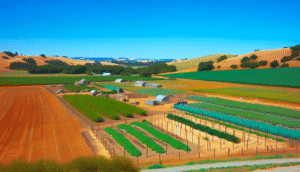What is Regenerative Agriculture?
Regenerative agriculture refers to a holistic farming approach that focuses on restoring and enhancing soil health, increasing biodiversity, and revitalizing the agricultural ecosystem. The fundamental principles of regenerative agriculture include practices such as no-till farming, cover cropping, crop rotation, and integrating livestock into crop production systems. By adopting these practices, farmers can not only improve soil fertility and structure but also increase carbon sequestration, which is crucial in combating climate change [Nature].
Benefits of Regenerative Agriculture
One of the primary benefits of regenerative agriculture is its capacity to build healthier soils. This approach prioritizes the soil microbiome and encourages the proliferation of beneficial microorganisms, leading to improved nutrient cycling and enhanced crop resilience. Research indicates that regenerative practices can effectively mitigate soil erosion and nutrient loss, significantly boosting agricultural productivity over the long term. Moreover, as outlined by the United Nations Food and Agriculture Organization, regenerative methodologies contribute to increased biodiversity, allowing diverse species of plants and animals to thrive, further enhancing ecosystem services.
Economic Advantages of Regenerative Practices
Regenerative agriculture also offers substantial economic benefits. By reducing reliance on synthetic fertilizers and pesticides, farmers can lower input costs, thereby increasing profit margins. Additionally, products produced through regenerative methods often command premium prices, attracting environmentally conscious consumers. The approach stimulates community engagement, fostering connections between local farmers and consumers who value sustainable practices.
The Role of Regenerative Agriculture in Combating Climate Change
In terms of addressing climate change, regenerative agriculture plays a vital role. By enhancing soil carbon storage, it acts as a buffer against environmental degradation. As the UNFAO mentions, increased soil organic matter is essential for reducing atmospheric carbon levels, and regenerative practices contribute to this process effectively.
Challenges Facing Regenerative Agriculture
Despite these advantages, the future of regenerative agriculture faces challenges such as the need for wider acceptance among conventional farmers and potential initial financial burdens associated with transitioning practices. However, as success stories from farms worldwide illustrate, the transition is not only feasible but can lead to robust agricultural systems that are beneficial for the environment and local communities alike. For further insights into sustainable practices in agriculture, see our articles on innovations in farming and organic farming techniques.
Technological Innovations in Regenerative Agriculture
The landscape of regenerative agriculture is evolving rapidly as of 2025, driven by innovative technologies and methods designed to enhance productivity while promoting biodiversity. One major trend is the integration of precision agriculture technologies, which utilize data analytics and IoT devices to optimize water usage, soil health, and crop yields. These technological advances facilitate real-time monitoring of soil conditions and crop performance, allowing farmers to make informed decisions that support sustainability efforts.

Government Support for Regenerative Agriculture
Government policies significantly influence the growth of regenerative agriculture through various incentives and support programs aimed at transitioning farmers toward sustainable practices. In the United States, the USDA provides specific initiatives, such as the Conservation Stewardship Program (CSP) and the Environmental Quality Incentives Program (EQIP), which offer financial and technical assistance to farmers adopting practices that improve soil health, enhance biodiversity, and conserve resources [USDA CSP].
Successful Case Studies in Regenerative Agriculture
Regenerative farming practices are transforming agricultural landscapes and communities around the globe. Here are several successful case studies demonstrating the substantial impact of these sustainable methods:
- Rodale Institute, Pennsylvania, USA: Pioneers since 1947, showing that organic practices can improve soil health and sequester carbon [Rodale Institute].
- Blue Nest Beef, USA: Employs regenerative grazing practices to enhance soil health and local ecosystems [Blue Nest Beef].
- Masanobu Fukuoka’s Farm, Japan: Demonstrated the “no-work” farming philosophy combining organic practices with respect for nature [Fukuoka Farming].
- Kallari Chocolate, Ecuador: Uses agroforestry to improve cacao production and enhance biodiversity [Kallari].
- Sustainable Harvest International (SHI): Partners with farmers in Central America to implement sustainable agriculture techniques [Sustainable Harvest International].
The Future of Regenerative Agriculture in the USA
The future of regenerative agriculture in the USA is poised for significant transformation driven by technological innovation and evolving consumer behavior. Advances in precision agriculture technologies are expected to enable farmers to monitor crop health and soil conditions more accurately. This, coupled with a growing demand for sustainably produced products, suggests a promising landscape for regenerative agriculture that can significantly benefit both the environment and the economy [IGN].
Frequently Asked Questions by Farmers
What are the benefits of regenerative agriculture for soil health?
Regenerative agriculture enhances soil health through practices that contribute to increased organic matter and microbial biodiversity, while also improving water retention and resilience against extreme weather events [Regenerative Agriculture Initiative].
What are the typical costs associated with transitioning to regenerative agriculture?
The costs can vary widely depending on factors such as farm size, but initial investment costs should be weighed against long-term savings and productivity increases [GreenBiz].
What financial incentives are available for farmers adopting regenerative agriculture?
Farmers can access grants, loans, and other financial support for implementing regenerative practices [USDA Conservation Programs].
How does regenerative agriculture mitigate climate change?
It enhances soil’s ability to sequester carbon and reduce greenhouse gas emissions through various agroecological practices [Climate & Soil].
What educational resources are available for farmers interested in regenerative agriculture?
A range of resources such as online courses, workshops, and literature from reputable organizations assist farmers in learning best practices [Rodale Institute].
Sources
- Blue Nest Beef – Blue Nest Beef
- Rodale Institute – Rodale Institute
- California CDFA – Healthy Soils Program
- Kallari – Kallari Chocolate
- Food Farming Journal – Government Policies & Support
- Sustainable Harvest International – Sustainable Harvest International
- GreenBiz – Transition Costs
- Nature – Regenerative Agriculture Study
- USDA Conservation Programs – USDA
- IGN – Future Innovations
- Climate & Soil – Mitigating Climate Change
- Regenerative Agriculture Initiative – Benefits of Regenerative Agriculture
- USDA CSP – Conservation Stewardship Program
- Fukuoka Farming – Masanobu Fukuoka’s Farm
“`